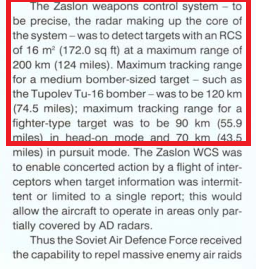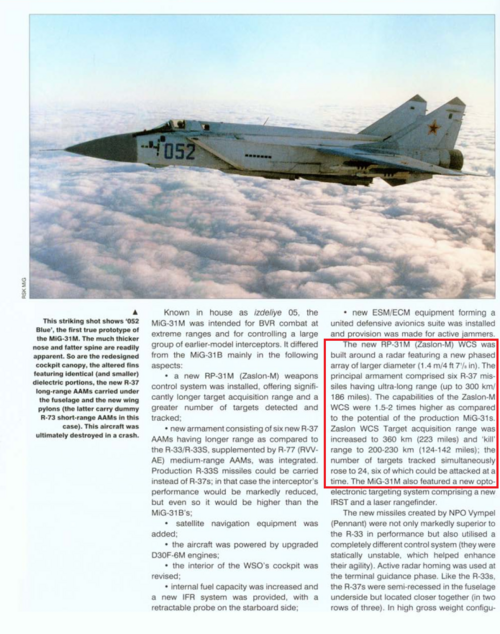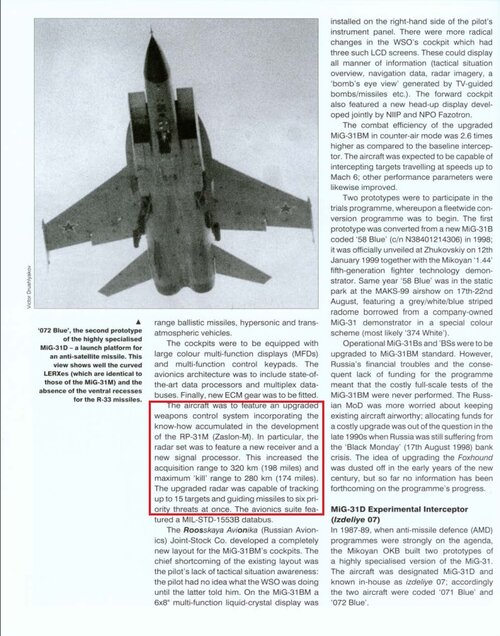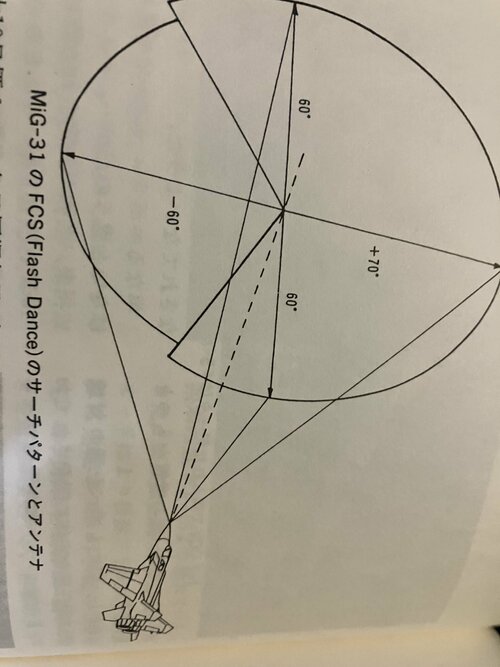FLIGHT TESTS SUV "ZASLON" - Vladimir Ilyin (Аэрокосмическое обозрение №05 2005)
The weapon control system (SV) "Zaslon", developed for the MiG-31 fighter-interceptor, is a unique product, many of whose characteristics have not yet been surpassed by foreign counterparts. The extremely high characteristics of the complex for its time were largely achieved through numerous, sometimes very large-scale (both organizational and financial) flight tests and experiments. Some of these experiments are still unique.
It should be noted that such experiments aimed at improving the capabilities of the aviation complex were also carried out after the MiG-31 was put into service. Let us dwell only on the individual, most significant stages of the development of the complex, carried out by the NIIP. V.V. Tikhomirova and OKB A.I. Mikoyan during flight tests of the MiG-31.
| Target acquisition range | |
| Number | Target acquisition and automatic tracking range, km | Target flight altitude, m |
| 1 | 141.3 | 1400 |
| 2 | 162.2 | 9000 |
| 3 | 136.5 | 2000 |
| 4 | 124.8 | 1700 |
| 5 | 131.5 | 2600 |
| 6 | 137.8 | 9300 |
| 7 | 144.3 | 8700 |
| 8 | 121.5 | 9600 |
| 9 | 112.2 | 2300 |
| 10 | 115.4 | 8400 |
On February 15, 1978, Akhtubinsk hosted a flight experiment that has not been repeated by any foreign aviation complex so far for the simultaneous detection, capture and tracking of 10 air targets flying in a wide front (about 150 km) at various altitudes.
The MiG-31 interceptor flew at an altitude of 5000 m. The targets were divided into two groups. The first group flew at altitudes from 8400 m to 9600 m, the second - from 1400 m to 2600 m, flying (relative to the interceptor) against the background of the underlying (terrestrial) surface. The maximum target detection range (having an EPR of the order of 16 m2) was 210 km.
The total time of detection and capture was 153.5 s. At the same time, the first seven targets were detected and captured in 69.5 s. The time spent directly on the procedure for capturing seven targets was 24.3 s, and 10 targets - 49.05 s.
To avoid multiple capture of the same target and, as a result, "looping" of the system, a comparison of the coordinates of newly captured targets and a ban on their re-capture was introduced.
It should be noted that the possibility of multiple acquisition and tracking of the same target in one flight experiment made it possible to estimate the load of computational processes and collect statistics on the observation of target signals (mode for experimental work) without organization in the future of expensive flights of 10 targets.
The creation of a phased antenna array (PAR) for the SUV "Zaslon" made it possible not only to implement the multi-purpose operation of the radar complex, but also to work out the use of the so-called "sequential detector" mode to increase the range.
In this case, the analysis is carried out within two to four elementary time cycles (the position of the PAR beam remains unchanged). The lower and upper thresholds are different for each measure. When the upper threshold is exceeded in each of the 180 sections of Doppler frequencies, a “target” signal is generated.
The sequential detector made it possible to obtain a gain in the detection range of air targets, which is approximately 20-25%. In this case, the entire procedure for sequential detection is implemented in a special analog-to-digital processor. The implementation of this mode in modern digital signal processors is problematic due to insufficient speed and the need to organize a special computing process.
On August 28, 1978, the MiG-31 successfully hit four radio-controlled air targets with four simultaneously fired R-33 missiles.
On August 18, 1993, a series of flight experiments was carried out to intercept a target at maximum range. During the first of them, a radio-controlled target flying at an altitude of 10.300 m at a speed of 189 m / s was captured by a MiG-31 interceptor (flight altitude 8480 m, speed - 669.3 m / s) at a distance of 319.5 km. The R-33 missile (which successfully hit the target) was launched at a range of 228 km.
Perhaps the most spectacular flight experiment, which fully demonstrated the capabilities of the aviation complex, was the experiment conducted on April 21, 1994, on the simultaneous firing of four air targets. As the latter, specially equipped MiG-21 fighters (controlled from ground command posts) were involved, which had a relatively low EPR and high maneuverability.
The first target flew at an altitude of 7100 m, the second - 1720 m, the third - 2470 m, the fourth -6230 m. The sequence of target firing was determined by the program of the MiG-31 computer system: 4-2-3-1. All targets maneuvering along the course were destroyed a few tens of kilometers from the interceptor fighter.
Thus, SUV "Barrier" in conditions as close as possible to real, confirmed its unique characteristics. It should be noted that even today the MiG-31 aviation complex, created back in 1968-1981, has not exhausted its evolutionary possibilities. Its modernization will significantly increase its combat potential and give it characteristics that meet the requirements for fighter-interceptors of the 21st century.
For the creation of the SUV "Barrier" and its modifications, 196 employees of NIIP were awarded orders and medals of the USSR.
And the development of the SUV "Barrier" began in 1968. At first, it was difficult and difficult to move forward. All technical solutions were new: phased array, quasi-continuous radiation, multi-purpose work, group actions, etc. Now, 37 years later, they have become
familiar, understandable and, as a matter of course, indispensable in every new development. At the same time, it is important to note that the main technical solutions were immediately chosen correctly, but their practical implementation was an extremely difficult task.
In the process of working on the SUV "Zaslon", a creative association of specialists from different organizations was formed.
Involvement in solving a priority problem, the scale of work and the highest level of scientific and technological tasks brought together the specialists of the developer's firm - the Research Institute of Instrument Engineering, the Leninets serial plant and many enterprises and services of science, industry and the customer.
But the most important result of the development of the Zaslon SUV was the creation at the NIIP of a scientific and technical school for the development of antenna systems and radars with electronic beam control, which today is capable of carrying out the most complex and advanced developments for both aviation and anti-aircraft missile systems




